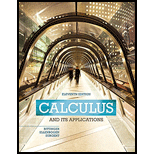
Compound interest. If
a. Find the rate of change,
b. b) Interpret the meaning of
Want to see the full answer?
Check out a sample textbook solution
Chapter 1 Solutions
Calculus and Its Applications Plus MyLab Math with Pearson eText -- Access Card Package (11th Edition) (Bittinger, Ellenbogen & Surgent, The Calculus and Its Applications Series)
Additional Math Textbook Solutions
Basic Business Statistics, Student Value Edition
Introductory Statistics
Elementary Statistics (13th Edition)
Elementary Statistics
Algebra and Trigonometry (6th Edition)
Thinking Mathematically (6th Edition)
- 7. What are all values of 0, for 0≤0<2л, where 2 sin² 0=-sin? - 5π 6 π (A) 0, л, and 6 7π (B) 0,л, 11π , and 6 6 π 3π π (C) 5π 2 2 3 , and π 3π 2π (D) 2' 2'3 , and 3 4元 3 1 די } I -2m 3 1 -3 บ 1 # 1 I 3# 3m 8. The graph of g is shown above. Which of the following is an expression for g(x)? (A) 1+ tan(x) (B) 1-tan (x) (C) 1-tan (2x) (D) 1-tan + X - 9. The function j is given by j(x)=2(sin x)(cos x)-cos x. Solve j(x) = 0 for values of x in the interval Quiz A: Topic 3.10 Trigonometric Equations and Inequalities Created by Bryan Passwaterarrow_forwardcan you solve this question using the right triangle method and explain the steps used along the wayarrow_forwardcan you solve this and explain the steps used along the wayarrow_forward
- can you solve this question and explain the steps used along the wayarrow_forwardcan you solve this question using partial fraction decomposition and explain the steps used along the wayarrow_forwardIntegral How 80*1037 IW 1012 S е ऍ dw answer=0 How 70+10 A 80*1037 Ln (Iwl+1) du answer=123.6K 70*1637arrow_forward
- Algebra & Trigonometry with Analytic GeometryAlgebraISBN:9781133382119Author:SwokowskiPublisher:Cengage
 Glencoe Algebra 1, Student Edition, 9780079039897...AlgebraISBN:9780079039897Author:CarterPublisher:McGraw Hill
Glencoe Algebra 1, Student Edition, 9780079039897...AlgebraISBN:9780079039897Author:CarterPublisher:McGraw Hill Trigonometry (MindTap Course List)TrigonometryISBN:9781337278461Author:Ron LarsonPublisher:Cengage Learning
Trigonometry (MindTap Course List)TrigonometryISBN:9781337278461Author:Ron LarsonPublisher:Cengage Learning 
 Big Ideas Math A Bridge To Success Algebra 1: Stu...AlgebraISBN:9781680331141Author:HOUGHTON MIFFLIN HARCOURTPublisher:Houghton Mifflin Harcourt
Big Ideas Math A Bridge To Success Algebra 1: Stu...AlgebraISBN:9781680331141Author:HOUGHTON MIFFLIN HARCOURTPublisher:Houghton Mifflin Harcourt Algebra: Structure And Method, Book 1AlgebraISBN:9780395977224Author:Richard G. Brown, Mary P. Dolciani, Robert H. Sorgenfrey, William L. ColePublisher:McDougal Littell
Algebra: Structure And Method, Book 1AlgebraISBN:9780395977224Author:Richard G. Brown, Mary P. Dolciani, Robert H. Sorgenfrey, William L. ColePublisher:McDougal Littell





